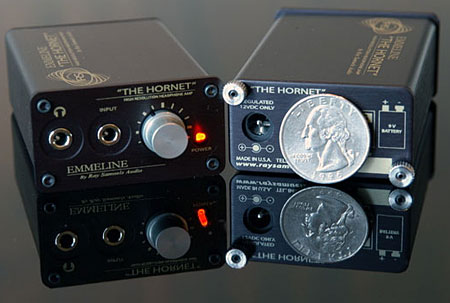| Columns Retired Columns & Blogs |
Ray Samuels Audio Emmeline The Hornet headphone amplifier Page 2
Sam Tellig wrote about the Hornet in September 2006 (Vol.29 No.9):
I haven't met Ray Samuels, except by phone, but I have one of his products in my hands right now. Well, actually, I have it in the palm of one hand: the incredibly tiny Emmeline The Hornet portable headphone amp, which I heard about from Wes Phillips via the Stereophile e-newsletter of June 1, 2006.
As soon as I read what Wes said, I knew I had to have a Hornet. Not because I own an iPod—I don't and probably, just to be contrarian, never will—but because I take my Sony D-EJ100 portable CD player to the library, where I play music to block out the noise of nattering librarians and chirping children. Libraries are noisy places these days. Just like the rest of America.

But good as the Sony D-EJ100 is, its little op-amp is not up to driving more than a set of casual earbuds. Hence the need for a portable headphone amp. And I mean portable, as in shirt-pocket portable. The Hornet fits the bill—er, pocket.
The Hornet measures 3" long by 2" wide by 1" high and comes in six colors: black, silver, red, gold, blue, or green. It runs on one 9V battery, not included in the $350 price—but an AC adapter is included. Add $15 for a pair of rechargeable NiMH batteries. Note that only NiMH batteries can be used, and only with the supplied charger. You can also use the nonrechargeable 9V brand of your choice. Just be sure you don't forget what you have in there, because if you try to recharge a nonrechargeable battery it will likely explode, and in the process exterminate your $350 Hornet.
The Hornet is a marvel of miniaturization—there's good stuff inside: tantalum and film capacitors, 0.1% Vishay resistors, a milspec OFC printed-circuit board. A 15,000µF filter capacitor buffers the Hornet's op-amp chip with a secret circuit about which Ray Samuels keeps mum. (It's astonishing that Ray can get sound this good from an op-amp—a mere integrated circuit.)
The Hornet is a joy to use. It's got a mini-plug line-level input and a mini-plug headphone output. These are spaced far enough apart so that most adapters will fit (if you're using headphones with a ¼" jack, for instance). The volume control is custom-made by Alps; Ray tweaks it so you have more control over the first half of its range. There are three gain settings on the back, which you can change by inserting the edge of a fingernail. The On/Off switch is illuminated by a red LED. When the LED dims, it's time to recharge. Playing time depends on the particular battery, how hungry your headphones are, and how loud you like your music. You can expect at least 13–14 hours of playback per charge.
This Hornet does anything but sting. It sings. I used Sennheiser HD600, Grado RS-1, and Grado SR60 headphones, and was captivated listening to chamber music with a little Sony portable I'd picked up at Wal-Mart: very smooth, sweet, and nicely extended in the treble. Surprisingly good bass and dynamic drive, too—which is what you don't get from the cheap op-amps built into most portable devices. Just the ticket for the library—or the train.
Ray Samuels sells direct rather than through dealers. He's quite helpful and enjoyable to talk with, but he did chew me out a little for listening with such an inexpensive CD portable, not to mention one that has no line out. Sorry, Ray—just try to find a high-quality CD portable these days. Now I'm sorry I didn't buy two Sony D-EJ100s.
I decided to try the Hornet with something better. I connected it directly to the Atoll CD200 and Rega Apollo CD players for further head-to-head comparisons. Doing so was a revelation. Through my Sennheiser HD600 headphones, the Hornet was, if anything, superior to the headphone output of the Atoll PR300 preamplifier. Perhaps I was hearing the limitations of the Atoll preamp itself—that tendency toward congestion and hardness during tough-going orchestral passages.
How much better does a headphone amp get? Well, there's the Cayin HA-1A vacuum-tube headphone amp for $799 from Acoustic Sounds. But that, of course, is a different animal—it's anything but portable. And there's the new Raptor tubed headphone amp from Ray Samuels himself. I expect a review sample any day. Meanwhile, I'm already in headphone heaven.—Sam Tellig
Sam Tellig returned to the Hornet in December 2006 (Vol.29 No.12):
Ray Samuels Audio's Emmeline The Hornet is creating quite a buzz in the headphone world. I reviewed this little—and by little I mean shirt-pocket, hold-in-the-palm-of-your-hand little—battery-powered headphone amp in the September issue, following Wezzuz (Wes Phillips's) June 1, 2006 writeup in our e-newsletter. I flipped. For $350, it will put you in headphone heaven, even if you're in some hellish place like an airport departure lounge. It comes in six colors, including light green for Christmas.
This is one you can stuff in a stocking. It's sold directly by Ray Samuels. Call and tell him Sam sent you.—Sam Tellig
- Log in or register to post comments




































